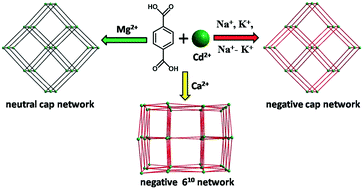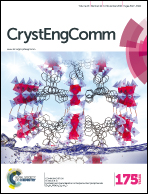Fluorescent heterometallic MOFs: tunable framework charges and application for explosives detection†
Abstract
A series of three-dimensional fluorescent heterometallic MOFs based on rod- and cluster-like building blocks were readily prepared under solvothermal conditions. Among them, compounds 1–4 were constructed from rod-like building blocks {Cd–O–M}n (M = Na, K, Na–K, and Mg) and BDC2− ligands, featuring right-hand and left-hand channels with a cap topology. The framework charges of 1–4 can be tuned from negative to neutral via a strategy of changing the secondary metal centre (Na+, Na+–K+, K+ and Mg2+). It is worth noting that the rod-like building block of compound 2 contained three types of metal ion centres (Cd2+, Na+ and K+). Different from compounds 1–4, the topology of 5 changed from a cap net to a 610 net in the presence of Ca2+ as a secondary metal centre. Interestingly, the anionic framework of 5 features two types of linear trinuclear clusters as the building blocks, i.e. {Cd2CaO17} and {Cd2CaO16}, which are relatively rare in known heterometallic open frameworks. Moreover, fluorescent compound 5 with a microporous structure displayed sensing properties towards some nitro-containing compounds, suggesting its potential application as a fluorescent sensor for the sensitive detection of explosives.


 Please wait while we load your content...
Please wait while we load your content...